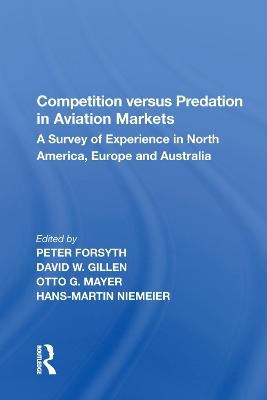
Competition versus Predation in Aviation Markets
Routledge (Verlag)
978-1-138-61911-1 (ISBN)
- Titel z.Zt. nicht lieferbar
- Versandkostenfrei innerhalb Deutschlands
- Auch auf Rechnung
- Verfügbarkeit in der Filiale vor Ort prüfen
- Artikel merken
Peter Forsyth, David W. Gillen, Otto G. Mayer and Hans-Martin Niemeier
Contents: Competition and Predation - Surveys from Different Perspectives: Strategic behaviour of incumbents, Kai Hüschelrath; Predatory pricing: still a rare occurrence? Ashish Lall; Competition and predation, Ruwantissa Abeyratne. Australia and New Zealand: Predatory behaviour in Australian aviation markets, Peter Forsyth; When does airline competition become predation? David Greig. North America: Predation in aviation: the North-American divide, David W. Gillen and Ashish Lall; Airline predation in Canada, Scott M. Butler; Most low-cost airlines fail(ed): why did Southwest Airlines prosper? Andreas Knorr and Andreas Arndt. Europe: The Lufthansa-Germania case at a glance, Kai Hüschelrath; Predatory pricing in the airline industry as a challenge to competition law enforcement, Christian Ewald; The European 'No-Frills'-aviation market: current and future developments, Bernard Michael Gilroy, Elmar Lukas and Tobias Volpert. Theoretical and Policy Aspects of Predatory Pricing and Competition: A case of beer and pretzels, William G. Morrison; Investigating airline managers' perception of route entry barriers: a questionnaire-based approach, Mirko C.A. Schnell; Why do low cost carriers arise and how can they survive the competitive responses of established airlines? a theoretical explanation, Markus Reisinger; A capacity lock-in rule, David Starkie; Wide angle preying in land modes? the problem of missing modes, Marc Gaudry; An economic framework for assessing predation in air services: markets, barriers to entry, market power and tests, Colin A. Gannon.
| Erscheinungsdatum | 26.07.2019 |
|---|---|
| Verlagsort | London |
| Sprache | englisch |
| Maße | 156 x 234 mm |
| Gewicht | 690 g |
| Themenwelt | Technik ► Fahrzeugbau / Schiffbau |
| Technik ► Luft- / Raumfahrttechnik | |
| Technik ► Umwelttechnik / Biotechnologie | |
| Wirtschaft ► Betriebswirtschaft / Management | |
| ISBN-10 | 1-138-61911-6 / 1138619116 |
| ISBN-13 | 978-1-138-61911-1 / 9781138619111 |
| Zustand | Neuware |
| Haben Sie eine Frage zum Produkt? |
aus dem Bereich


